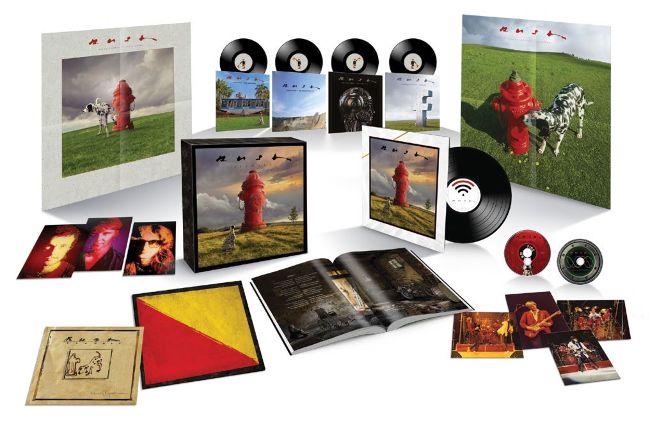Message Received
When Rush released their ninth studio album, Signals – their final record with longtime producer Terry Brown – one thing was clear: they had no intention of making another Moving Pictures. As the remaining members of the band prepare to unveil the 40th anniversary reissue, we uncover the space shuttle launch and unique Chemistry that inspired the birth of their keyboard era.
The Analog Kid: Dave Everley Image: Deborah Samuel Artwork: Hugh Syme
“Progress is important to us. We always need to go somewhere else. We always wanted to evolve.”
Alex Lifeson
The launch of the Space Shuttle Columbia on April 12, 1981 was the biggest leap forward in the Space Race since the Moon landing 12 years earlier. This was the very first reusable spacecraft, able to orbit the planet and return safely to Earth in one piece after its mission was complete.
Several NASA employees and a group of specially invited guests had gathered at 7am in a private viewing area within the grounds of the Kennedy Space Center on Merritt Island, Florida to watch billions of dollars’ worth of technology and two flesh-and-blood astronauts be fired into orbit. And among that group of onlookers were the three members of Rush.
The Canadian trio were guests of Kennedy Space Centre deputy director Gerry Griffin, who’d given them a tour of the facility, including the assembly building, a room so vast it had its own indoor cloud system. They’d also had a cheeky go on the Space Shuttle simulator during the tour, only for guitarist Alex Lifeson – a qualified pilot – to crash the computerised craft headfirst into a swamp.
The launch of the real thing was originally scheduled to take place two days earlier but it had been delayed due to technical problems. The change of date meant that Rush had to hightail it to Florida immediately after a show in San Antonio, Texas, then head back straight after to play another show in Fort Worth. But there was no way they were going to miss this.
And so Lifeson sat with bassist/ vocalist Geddy Lee and drummer Neil Peart on a blanket on the viewing area’s grass lawn, gazing over the lagoon in front of them to the launch pad a few kilometres away. As the countdown began, the already electric atmosphere began to intensify: five, four, three, two, one… Flames billowed from the shuttle’s booster rockets, a huge roar swept across the lagoon, and the Columbia lifted off.
“It was the most incredible thing I’ve ever heard,” says Alex Lifeson now, his voice still edged with awe. “It was so loud – the low end rumble of the rocket was incredible. It just screamed off in a plume of exhaust as it rose into the sky, and then it was gone into space and there was this eerie quiet. In this lagoon that was right in front of the viewing area, these dolphins came up and they started swimming in their little pattern. Here we are at the peak of human technology, and there’s such a great example of ancient nature right before us. The contrast was amazing.”

Signals’ 40th anniversary edition, out on April 28.
As the magnitude of what they had just seen sank in, Lifeson and his bandmates glanced around at their fellow guests. That’s when they spotted some familiar faces.
“We looked over and, a couple of spots to our left, Steven Spielberg and George Lucas were sitting on a similar blanket,” says the guitarist. “We didn’t know each other, but we just looked and nodded and smiled at the whole experience that we’d just had.”
Even the proximity of two Hollywood A-listers paled into insignificance next to the launch itself. Neil Peart was still processing what they’d witnessed as he boarded the plane they’d hired to get them to that evening’s gig.
“I remember thinking to myself as we flew back to Fort Worth after a couple days without sleep, ‘We’ve got to write a song about this!’” the drummer and lyricist later noted in a diary he wrote for Sounds magazine in 1982. “It was an incredible thing to witness, truly a once-ina-lifetime experience.’
Rush did indeed write a song about what they saw on that April morning. Countdown would appear as the propulsive closing track on their ninth album, Signals, its build-and-release energy mirroring the launch of the shuttle itself. As real-life voices from the NASA control room punctuate the song, Peart’s words capture the wonder and promise of the moment. ‘This magic day when super-science/Mingles with the bright stuff of dreams,’ sings Geddy Lee, bringing the drummer’s lyrics to life.
Signals was Rush’s own space shuttle moment. A bold step into the future that saw them embracing new sounds and new technology (and in the case of Lifeson, a snazzy new wave haircut), it opened up the rest of the decade for them. The album’s shorter songs and increased reliance on keyboards and synthesisers alienated the more obdurate section of their fanbase, but Signals was ultimately the sound of a band ready for the oncoming technological rush of the 1980s.
“I guess you could stay where you are and do the same thing over and over and over again, but that’s not the kind of band we are,” says Lifeson. “Progress is important to us. We always need to go somewhere else. We always wanted to evolve.”
Few Rush albums are as representative of that desire to move forward as Signals, yet it didn’t come completely out of the blue. The shift towards shorter songs had properly begun two albums earlier, with 1980’s Permanent Waves, while synths and keyboards had been an integral part of Rush’s sound since 1977’s A Farewell To Kings.